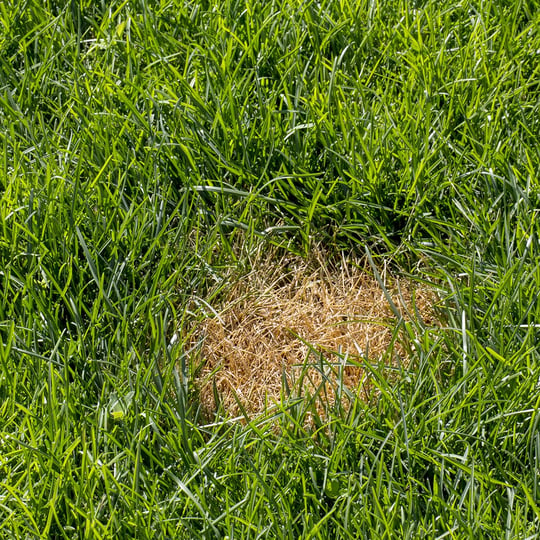Lawn Disease Library
Anthracnose

Scientific Name: Colletotrichum cereale
Common Name: Canker
Primary Grass Affected: Annual Bluegrass. Creeping Bentgrass
Brief Description: Dispersed patches of yellow or red grass with dying roots and signs of fungal hair.
What is Anthracnose?
Anthracnose is a common fungal infection that affects not only grass, but also trees and other foliage. It actually refers to a group of different fungi which all cause nearly identical symptoms, but grass is usually affected only by a single fungi, known as colletotrichum cereale.
Anthracnose tends to infect lawns at any point between April and early November. Spores are often dispersed through mowing, which is why this fungus more commonly affects large areas of well-manicured grass.
Signs and Symptoms of Anthracnose
Anthracnose causes discolored, patchy lawns and the appearance of sunken spots in well-manicured lawns. The discolorations are rarely uniform – green grass will usually be seen in between the discolored grass. There are no patterns to the infection necessarily.
Most anthracnose infections lead to yellow interspersed patches, but often the color depends on the grass type. Bluegrass and bentgrass are the most common grass types affected by anthracnose. Bentgrass anthracnose causes reddish tan patches. Bluegrass anthracnose causes yellowish brown patches.
The fungi grows inside of plant tissue, often in warm, damp weather (although some newer varieties are also resistant to cold). If you take a blade of infected grass up close, you should see black hair-like structures growing on the grass blades, surrounded by the yellow or brown rot. The black follicles should be nearer to the root of the blade. This is known as basal rot. When the entire root of the grass appears to be rotting it is known as “foliar blight.” The latter tends to occur in warmer climates.
How to Prevent Anthracnose
It is easier to prevent anthracnose than it is to eliminate it. The following are several strategies that can be used to decrease the likelihood of an anthracnose infestation:
- Choose Different Grass – Certain types of grass are far more resistant to the lawn disease than others. Since bluegrass and bentgrass tend to be infected the most, consider discussing other grass options with a lawn care specialist.
- Use a Balanced Fertilizer – Proper fertilization is also important. Both over and under-fertilizing can lead to anthracnose infestations.
- Proper Lawn Care – It’s also crucial that you do not cut lawns too short. This can lead to weak grass blades that are more prone to infection.
- Deep Watering – With anthracnose, it’s important that you water deep into the ground all at once rather than shallow watering.
- Do NOT Aerate If Anthracnose is Present – Usually, an aerated lawn is actually healthier for your grass. But it is recommended that anyone that has an anthracnose infestation avoids aeration until the anthracnose is removed.
As with all fungal infections, prevention is more effective than treatment, which may require you to replace the grass. Pre-infection fungal treatments are often recommended.
Need Help with Anthracnose?
Call today at and let's talk about how we can help you with Anthracnose and other Lawn Disease Library.